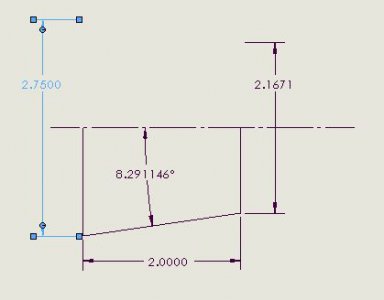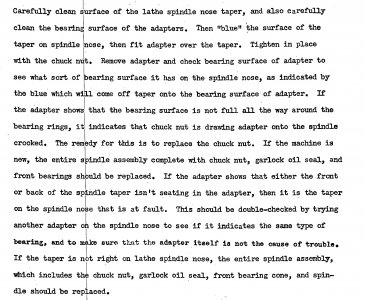- Joined
- May 7, 2015
- Messages
- 269
Hello all,
On my Clausing L-00 spindle and chuck.
I am having some run out issues on my chuck and adapter. Also some taper when I turn some round stock in just the chuck.
I have put a dial test indicator on my spindle, both when running and when hand turning the spindle and the run out is within .0005.
When I mount the chuck and perform the same run out test I get run out from .005" - .010"
When I turn round stock in just the chuck, I get .004" taper, smaller diameter, at the bar end away from the chuck.
I called Clausing and they sent me a service manual section.
It indicates that either the spindle collar is worn or the spindle nose taper is not true.
I took my adapter and put it on my mill and ran a dial indicator around both bearing surfaces and they are true to .0005".
I placed some plastiguage on the bearing surfaces of the adapter and mounted the adapter to the spindle.
The clearance was .002 on the rear bearing surface and .003 -.005 on the front bearing surface.
Now I need to determine how to measure the taper on the spindle nose. (again when running the dial test indicator on the spindle, there is very little run out).
What I now need to determine is if the spindle taper is worn.
If I can eliminate either the spindle nose or the spindle collar, my cost to repair will be less.
Can anyone tell me how to accurately measure spindle diameter taper on the spindle nose?
Thanks
Joe
On my Clausing L-00 spindle and chuck.
I am having some run out issues on my chuck and adapter. Also some taper when I turn some round stock in just the chuck.
I have put a dial test indicator on my spindle, both when running and when hand turning the spindle and the run out is within .0005.
When I mount the chuck and perform the same run out test I get run out from .005" - .010"
When I turn round stock in just the chuck, I get .004" taper, smaller diameter, at the bar end away from the chuck.
I called Clausing and they sent me a service manual section.
It indicates that either the spindle collar is worn or the spindle nose taper is not true.
I took my adapter and put it on my mill and ran a dial indicator around both bearing surfaces and they are true to .0005".
I placed some plastiguage on the bearing surfaces of the adapter and mounted the adapter to the spindle.
The clearance was .002 on the rear bearing surface and .003 -.005 on the front bearing surface.
Now I need to determine how to measure the taper on the spindle nose. (again when running the dial test indicator on the spindle, there is very little run out).
What I now need to determine is if the spindle taper is worn.
If I can eliminate either the spindle nose or the spindle collar, my cost to repair will be less.
Can anyone tell me how to accurately measure spindle diameter taper on the spindle nose?
Thanks
Joe



